Latest News
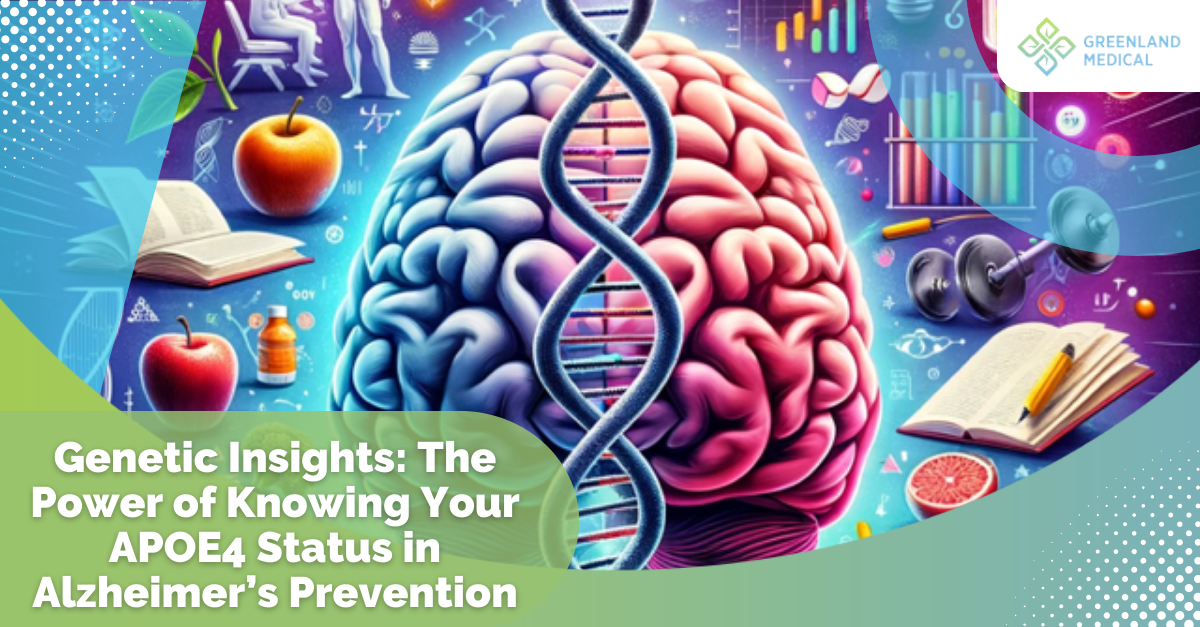
By Dr Andrew Greenland
•
04 Apr, 2024
Alzheimer’s disease, a formidable foe in the realm of cognitive disorders, remains a significant concern in our aging population. Central to this battle is understanding the genetic underpinnings of Alzheimer’s, notably the APOE4 gene. APOE4, a variant of the Apolipoprotein E gene, has been identified as a key genetic factor influencing the risk of developing Alzheimer’s disease. The APOE4 Gene: A Double-Edged Sword APOE4 is not just a marker for Alzheimer’s; it serves a broader role in lipid metabolism, impacting cardiovascular health. Individuals with the APOE4 variant may experience altered blood lipid profiles, potentially increasing their risk for cardiovascular diseases. This multifaceted impact underlines the gene’s significance in holistic health assessments. Empowerment Through Genetic Knowledge Understanding one’s APOE4 status transcends mere knowledge; it’s a strategic advantage in preemptive health management. Although genetics are a blueprint we inherit, they are not a fixed destiny. The burgeoning field of epigenetics teaches us that environmental factors and lifestyle choices can influence how genes are expressed. This principle is at the heart of the Bredesen protocol, which recognizes APOE4 status as a pivotal diagnostic marker. The Bredesen Protocol: Tailoring Treatment to Genetic Insights For practitioners and patients alike, knowing APOE4 status is empowering. It allows for specific adjustments to holistic treatment plans, ensuring patients thrive despite their genetic predispositions. The Bredesen protocol, an integrative approach to Alzheimer’s treatment, leverages this genetic insight to craft personalized strategies that address the multifactorial nature of the disease. Genetic Testing: A Proactive Approach to Alzheimer’s Prevention For those with a strong family history of Alzheimer’s, genetic testing, including APOE4 status, is a valuable tool in early prevention strategies. Understanding genetic risks enables individuals and healthcare providers to implement targeted interventions focused on lifestyle, nutrition, and other modifiable factors to optimize brain health and potentially delay or prevent the onset of Alzheimer’s. The Role of Qualified Practitioners in Genetic Navigation Navigating the complexities of genetic testing and interpretation requires expertise. Working with a qualified Bredesen practitioner can be invaluable. These practitioners are equipped to not only understand the nuances of genetic tests but also to empower patients with targeted strategies. They focus on optimizing brain health in the face of genetic risks, creating a proactive and personalized approach to Alzheimer’s prevention. Conclusion In the journey of health and wellness, knowledge indeed is power. Understanding one’s genetic makeup, particularly the APOE4 status, offers a unique advantage in preemptively managing health risks. It empowers individuals and healthcare professionals to make informed, targeted decisions, turning genetic insights into actionable strategies for thriving health.
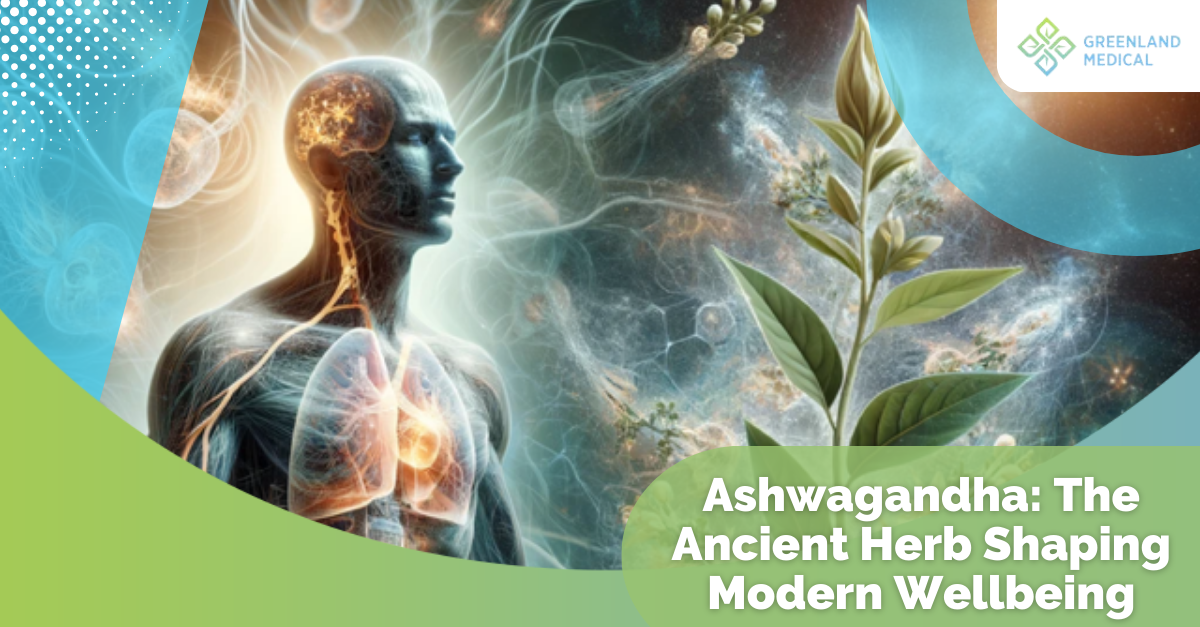
By Dr Andrew Greenland
•
01 Apr, 2024
The Ayurvedic Jewel: A Journey through Time Ashwagandha, a name that resonates with a history as rich as its properties, is more than just an herb; it’s a testament to the ancient wisdom of Ayurveda. Originating from the sun-drenched plains of India and the Middle East, ashwagandha has been a cornerstone of traditional Ayurvedic medicine for over 3,000 years. Its botanical name, Withania somnifera, speaks of its essence – a blend of vitality and tranquility. Adaptogen: Nature’s Response to Stress One of the key highlights of ashwagandha is its role as an adaptogen. But what exactly does this mean? Adaptogens are a unique class of healing plants. They help restore balance and protect the body by enhancing its ability to cope with stress, fatigue, and anxiety. Think of them as a thermostat; when the thermostat senses that the room temperature is too high or too low, it brings it back to equilibrium. Similarly, adaptogens modulate our body’s stress response, maintaining an optimal balance. A Nervine Relaxant and Cortisol Modulator In today’s fast-paced world, where stress is often a constant companion, ashwagandha’s properties as a nervine relaxant are particularly valuable. It gently soothes the nervous system, acting as a balm to frayed nerves. This calming effect is partially attributed to its ability to regulate cortisol levels, the body’s stress hormone. By normalizing cortisol levels, ashwagandha helps reduce stress and enhance mood, offering a natural way to bring about relaxation and tranquility. Beyond Pharmaceuticals: The Gentle Power of Botanicals While modern pharmaceuticals have undeniably contributed to health and wellness, there’s a growing recognition of the benefits of botanicals like ashwagandha. These natural remedies offer a gentler, often safer alternative. Their multifaceted action, coupled with fewer side effects, makes them a preferable option for many seeking holistic wellbeing. Ashwagandha, with its myriad therapeutic actions, exemplifies the potential of botanicals in modern integrative healthcare. Embracing Nature’s Gift As we continue to explore the confluence of traditional wisdom and modern science, ashwagandha stands out as a beacon of hope and health. Its holistic approach to wellbeing – impacting physical, emotional, and mental health – aligns perfectly with the principles of Integrative Functional Medicine. Incorporating ashwagandha into daily life could be a step towards embracing a more balanced, health-focused lifestyle. However, it is important to remember that while botanicals offer immense benefits, they are part of a larger wellness tapestry that includes diet, exercise, and lifestyle.
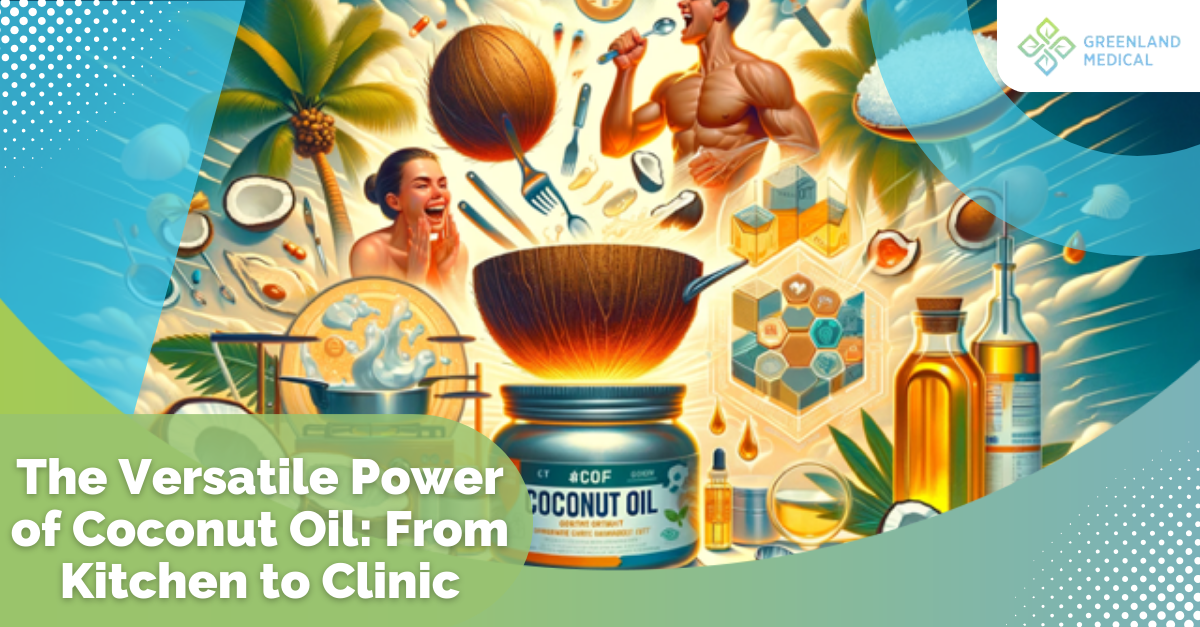
By Dr Andrew Greenland
•
25 Mar, 2024
In the bustling landscape of dietary trends and wellness practices, coconut oil emerges as a multifaceted powerhouse. Its unique properties make it a staple both in culinary ventures and therapeutic applications. This article delves into the remarkable versatility of coconut oil, exploring its role as a heat-stable cooking medium, a dental health enhancer, a skin moisturiser, and its synergistic relationship with ketogenic diets, especially in the context of the Bredesen protocol. A Culinary Champion: Heat Stability Matters Coconut oil stands out in the culinary world for its exceptional heat stability. Unlike many commonly used oils, such as olive or flaxseed oil, coconut oil maintains its integrity at high temperatures. This stability is crucial; oils that are fragile under heat can degrade, producing harmful compounds. The high smoke point of coconut oil makes it an ideal choice for various cooking methods, ensuring both safety and flavor. Beyond the Kitchen: A Therapeutic Ally The therapeutic uses of coconut oil are diverse. One notable practice is ‘oil pulling,’ a traditional dental technique. Swishing coconut oil in the mouth for a period can enhance oral health by reducing harmful bacteria and improving gum health. Furthermore, its moisturizing properties make coconut oil a natural choice for skin care, offering hydration and nourishment. The Magic of MCTs and the Ketogenic Connection Medium-chain triglycerides (MCTs) are where coconut oil truly shines in a health context. MCT oil, often derived from coconut oil, is a concentrated source of these beneficial fats. MCTs are directly absorbed into the bloodstream, providing a quick energy source and supporting ketone production. This makes MCT oil an excellent adjunct to ketogenic diets, such as those recommended in the Bredesen protocol for cognitive health. The ketogenic diet, which emphasizes high fat and low carbohydrate intake, can significantly benefit from the inclusion of MCTs for their ability to induce and sustain ketosis. A Note of Caution: The Cholesterol Conundrum Despite its many benefits, it’s important to address that coconut oil is unique in being the only significant plant-based source of saturated fat. This aspect means that for some individuals, particularly those with concerns about cholesterol levels, coconut oil might need to be used judiciously. The impact of coconut oil on cholesterol patterns varies among individuals, and it’s crucial to tailor its use to one’s health profile. In Conclusion Coconut oil’s versatility, from enhancing culinary experiences to supporting health and wellness practices, is remarkable. Its role in supporting ketogenic diets, like the Bredesen protocol, further underscores its therapeutic potential. However, it’s essential to approach its use with an understanding of individual health needs, especially concerning cholesterol management.

By Dr Andrew Greenland
•
15 Jan, 2024
As a medical professional deeply rooted in the field of Integrative Functional Medicine, I’ve seen firsthand the impact of long-haul flights on our health. Flying, especially over extended periods, isn’t just a matter of enduring cramped seats and minimal legroom. It’s a journey fraught with health challenges, from radiation exposure to the risk of blood clots, and more. However, fear not, for there are effective, holistic strategies to ensure you arrive at your destination as healthy as when you departed. Understanding the Sky-High Risks Before we delve into solutions, it’s crucial to understand the risks inherent in long-haul flights. Radiation exposure, while not immediately harmful, can be a concern, especially for frequent flyers. This cosmic radiation is more intense at high altitudes, posing a subtle risk over time. Blood clots, or deep vein thrombosis (DVT), are another significant concern. Prolonged immobility can impede blood flow, increasing the risk of clotting. Dehydration, often overlooked, exacerbates this risk, compounded by the dry, recycled cabin air. Another aspect often neglected is the quality of in-flight meals. Typically processed and low in nutrient density, these meals do little to support our immune system, which is already under stress from exposure to germs in a confined space. Lastly, the disorientation of crossing multiple time zones leads to jet lag, disrupting our circadian rhythms and impacting overall well-being. Holistic Strategies for In-Flight Wellness 1. Hydration is Key : Start hydrating well before your flight. Opt for water or herbal teas over caffeine and alcohol, which can further dehydrate you. 2. Combat Radiation : Antioxidants are your allies here. Consider a diet rich in antioxidants in the days leading up to your flight. Foods like berries, nuts, and green leafy vegetables can be beneficial. 3. Move Regularly : To reduce the risk of DVT, make it a point to stand, stretch, and walk down the aisles every couple of hours. Compression socks are also a great preventative measure. 4. Boost Your Immune System : Bring your own healthy snacks. Almonds, carrot sticks, or even a homemade salad can be far more nourishing than typical airplane food. 5. Manage Jet Lag : Adjust to your destination’s time zone a few days before flying. Gradually shifting your sleep schedule can lessen the impact of jet lag. 6. Air Quality Control : Use a saline nasal spray to keep your nasal passages moist, reducing the risk of infections. 7. Mindful Breathing : Stress exacerbates almost all health risks. Practice mindfulness and deep breathing to stay calm and centered. Arriving in Good Health Remember, your journey doesn’t end at landing. Continue these practices post-flight to ensure a smooth transition. Stay hydrated, maintain a healthy diet, and gently adjust to the local time zone with appropriate light exposure. Encouraging Healthy Flying Flying doesn’t have to be a health hazard. By implementing these simple yet effective strategies, you can safeguard your well-being, ensuring that you not only survive your long-haul flight but thrive during and after it.

By Dr Andrew Greenland
•
21 Dec, 2023
In this fast-paced world, we frequently follow different wellness routines in our pursuit of calm and mental clarity. Among these, Non-Sleep Deep Rest (NSDR), especially in the form of Yoga Nidra, is noteworthy for its simplicity and deep effect. This age-old method, which has its roots in the yoga tradition, provides a special means of revitalizing the body and mind without falling asleep. Recognizing Non-Sleep Intense Sleep and Yoga Nidra As the term implies, non-sleep-related deep relaxation (NSDR) entails a state of awareness distinct from sleep. "Yoganic sleep" is the translation for Yoga Nidra, a particular type of NSDR. This word is a little misleading, though. Yoga Nidra is a type of meditation in which practitioners lie down in a comfortable position and follow a guided technique to enter a state of awareness halfway between awake and asleep. This transitional realm is where the mystique of Yoga Nidra materializes. The Advantages: Not Just Calmness Yoga Nidra has many advantages and has been the focus of many research investigations. Here are a few main benefits: 1. Stress Reduction: Chronic stress is a frequent disease in our fast-paced lives. By stimulating the parasympathetic nerve system, which is the body's rest-and-digest mechanism, yoga nidra can successfully lower stress levels. 2. Better Sleep Quality: Regular practice can educate the body to relax deeply, which can improve the quality of sleep even if it can't replace sleep itself. 3. Enhanced Cognitive Function: Yoga Nidra helps focus, memory, and cognitive agility by relieving the mind of constant ideas. 4. Emotional Balance: Consistent practitioners frequently report feeling more emotionally resilient and stable, which makes it easier for them to deal with life's ups and downs. 5. Physical Health advantages: Scientific evidence is beginning to support the physical health advantages of yoga nidra, which range from lowering blood pressure to reducing chronic pain. Performing Yoga Nidra: An Easy But Deep Method It is possible for everyone, regardless of age or physical capacity, to practice Yoga Nidra. The following actions are usually involved: 1. Get ready by locating a calm, cozy area. With your arms at your sides and your hands facing up, take a flat, prone position. For additional comfort, use blankets or pillows as needed. 2. Making a Personal Intention: Prior to starting, make a "Sankalpa," or intention. This could be an objective, an encouraging statement, or an emotion you want to develop. 3. Guided Meditation: Participate in a Yoga Nidra session that is led by a guide and progresses through several phases, such as breath awareness, body scanning, and imagery. Either a live instructor or a recorded session can provide this instruction. 4. Concluding the Practice: Return your focus gradually to your body and environment. Before getting up, move slowly and give yourself some time to think back on your experience. Including Yoga Nidra in Your Daily Practice It doesn't take a lot of time to incorporate Yoga Nidra into your schedule. Benefits can be observed after as little as ten to fifteen minutes of exercise. Although many people find that practicing before bed improves the quality of their sleep, it can be advantageous at any time of day. Conclusion Non-Sleep Deep Rest with Yoga Nidra provides a profound means of restorative and rejuvenation. It's a useful tool in anyone's wellness toolbox because it's an approachable and very beneficial practice, especially in our high-stress contemporary environment. If you give it a shot, you might find that you can relax and think more clearly.

By Dr Andrew Greenland
•
18 Dec, 2023
In a world where the 24-hour society increasingly encroaches on our natural rhythms, an old adage whispers a reminder of a simpler time: "For every hour of sleep before midnight counts for two afterwards." But how much scientific truth lies behind this saying? As a medical practitioner specializing in Integrative Functional Medicine, I find it essential to sift through folklore to uncover evidence-based insights. Today, let’s unravel this nocturnal enigma, exploring its connections with our circadian rhythm, the role of melatonin, and our intrinsic link to the natural light-dark cycle. Circadian Rhythm: The Internal Symphony Conductor At the heart of this discussion is our circadian rhythm, the body's internal clock that orchestrates a multitude of biological processes. This rhythm, largely dictated by light exposure, regulates our sleep-wake cycle, hormone release, and even mood and cognitive functions. As per our evolutionary blueprint, human beings were designed to sleep when dark and arise with the light. The significance of sleeping before midnight becomes apparent when we consider the circadian rhythm's peak production of melatonin, the 'sleep hormone'. Melatonin levels typically rise in the evening and peak during the night, signalling to our body that it's time to rest. However, this peak occurs earlier than midnight, suggesting that the hours leading up to it are prime time for initiating sleep. Melatonin and Light: A Delicate Dance Our modern lifestyles, with artificial lighting and screen exposure, have tinkered with this delicate dance between melatonin and light. Exposure to bright lights in the evening can delay melatonin production, pushing our sleep timing later and potentially disrupting the quality of rest. This disruption can have a domino effect on various aspects of health, underscoring the importance of aligning our sleep patterns with natural light rhythms. Scientific Perspective: Quality Over Quantity? While the adage implies a quantitative measure – one hour before midnight equals two after – science suggests a qualitative perspective. The deep, restorative stages of sleep, primarily occurring in the early part of the night, are crucial for cognitive function and overall health. Therefore, it's not just about accumulating hours of sleep but ensuring those early hours are undisturbed and aligned with our natural rhythms. Adapting to Our Innate Design Acknowledging our intrinsic design to be asleep when dark and awake when light, it becomes evident that our best restorative sleep aligns with these natural cues. Early sleep times facilitate synchronization with our circadian rhythm, enhancing sleep quality and overall well-being. Closing Thoughts: Embracing Our Natural Sleep Patterns In conclusion, while the old saying might not hold up in a literal sense, it underscores a timeless truth about the importance of aligning our sleep with natural rhythms. As we navigate our busy lives, let’s not forget the wisdom embedded in our biology – respecting our circadian rhythms is key to optimal health and well-being.
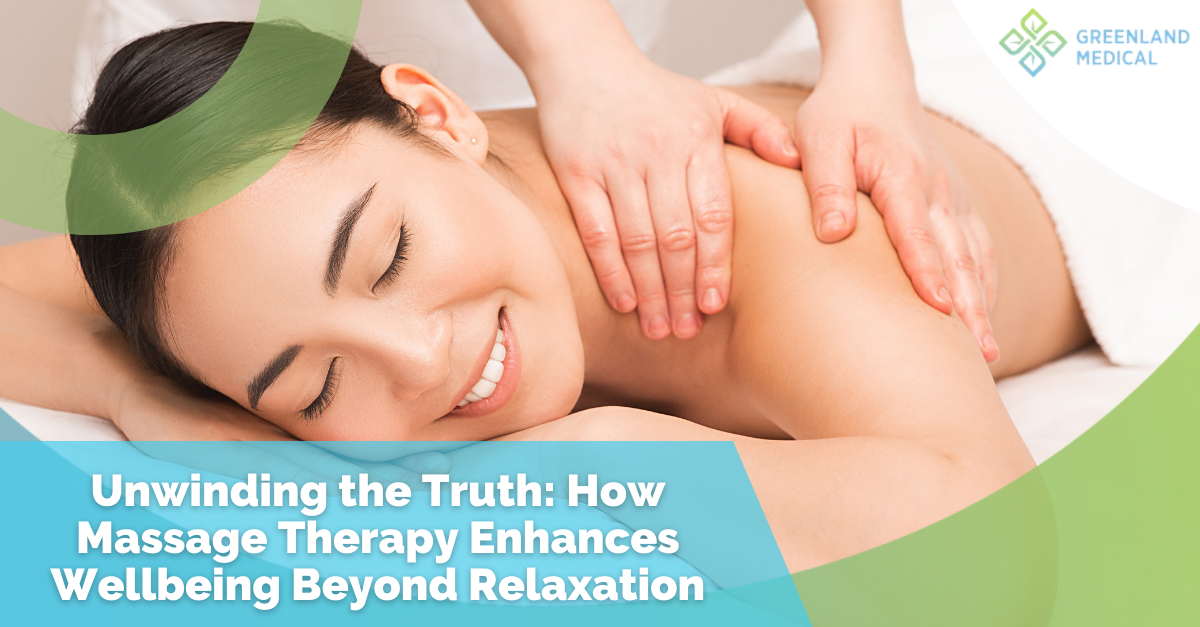
By Dr Andrew Greenland
•
18 Dec, 2023
Finding havens of peace and healing is essential amid the busy streets of contemporary life, when the obligations of work and personal obligations collide. As a physician who specializes in integrative functional medicine, I have seen firsthand the significant positive effects of massage treatment on both physical and emotional health. This age-old ritual, which is sometimes considered a luxury, is actually an essential aspect of a comprehensive self-care regimen, especially for people who exercise vigorously and engage in strength and cardiovascular training. The Mechanisms Underpinning the Calm Massage therapy goes beyond simple relaxation. It's a scientifically grounded art that has real physiological advantages. Muscles that undergo the strain of exercise get minute tears in them. Although it might cause stiffness and soreness in the muscles, this is a typical phase of developing strength and endurance. As a healer, massage therapy helps by increasing blood flow to these areas, hastening the healing process and relieving pain. Additionally, massage can be an effective ally in the fight against the stress reaction. The body feels less of the notorious stress hormone cortisol during a massage, but it also feels more of the neurotransmitters dopamine and serotonin, which are essential for promoting emotions of contentment and relaxation. This change in the body not only promotes better sleep but also elevates mood and promotes relaxation. Personal Testimony: Not Just Counseling For me, getting regular massages has been essential to preserving the best possible physical and emotional well-being. I find that having a professional massage greatly relieves pain and stress in my muscles after intense workouts. This is about providing the body with the attention it requires to heal and flourish, not just about indulging. Including Massage in Healthcare I support the inclusion of massage therapy in standard treatment regimens as a healthcare practitioner. It ought to be seen as an essential part of a comprehensive wellness regimen rather than as a one-time luxury. Frequent massage therapy sessions can result in increased physical performance overall, decreased chance of injury, and improved flexibility. An Appeal to Adopt Wellbeing I extend an invitation to you, my friends, patients, and coworkers to learn more about the many advantages of massage treatment. Massage offers a route to balance and well-being, whether it's to ease sore muscles from overuse, control stress, or just to carve out a peaceful minute in a busy world. Together, let's exchange stories and perspectives from our journeys towards wellbeing. Let's talk whether you have experienced the benefits of massage treatment or if you have any questions about incorporating it into your overall wellness regimen.
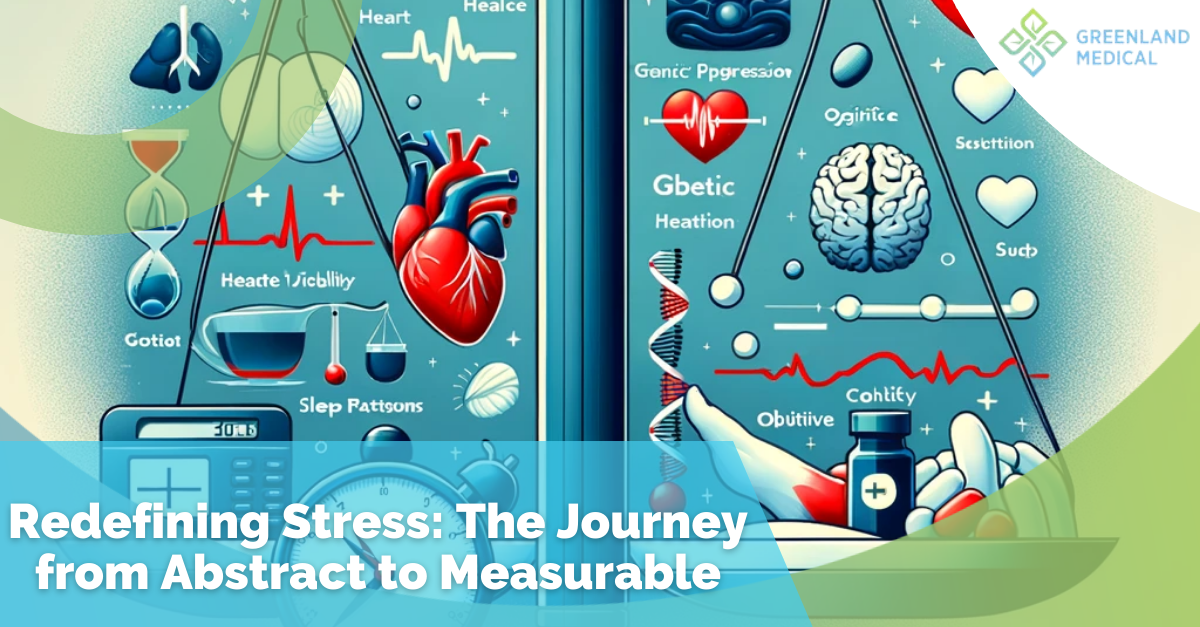
By Dr Andrew Greenland
•
17 Dec, 2023
In an age where 'stress' has become a common refrain in our daily lexicon, its ambiguity persists. As a medical doctor specializing in Integrative Functional Medicine, I've often pondered upon this elusive concept. It's time we explore stress not just as a subjective experience but as a quantifiable entity. Stress, in its essence, is when the amalgamation of psychological, physiological, and physical demands eclipses our resources to cope within a given timeframe. This definition, while insightful, demands a deeper exploration. Unveiling the Layers of Stress Stress, inherently subjective, varies in its impact and manifestation across individuals. This disparity poses a challenge in objective measurement, an endeavour that is increasingly vital in our high-stress society. Expanding the Toolbox: Innovative Metrics for Stress Measurement ● Heart Rate Variability (HRV): The Rhythm of Stress Beyond the basics of heart rate and cortisol, HRV emerges as a fascinating metric. It represents the variation in time intervals between heartbeats, serving as a window into our autonomic nervous system. A higher HRV indicates a robust, responsive system, capable of adapting to stress effectively. Conversely, lower HRV suggests a system under duress, less capable of coping with external stressors. By monitoring HRV through wearable technology, we gain insights into an individual's stress resilience and overall cardiac health. ● Epigenetics and Stress: Stress leaves a signature at the genetic level. Telomere length, a marker of cellular aging, shortens under chronic stress. Additionally, DNA methylation patterns, which regulate gene expression, also alter in response to prolonged stress. These changes can be indicative of the long-term impact of stress on our biological systems. ● The Sleep-Stress Nexus: The quality and patterns of our sleep are profoundly influenced by stress. Wearable sleep trackers can provide detailed insights into sleep architecture, including changes in deep sleep phases and REM sleep disruptions, which often correlate with elevated stress levels. ● Gastrointestinal Responses The gut-brain axis is a critical player in our stress response. Variations in gut microbiota composition, identified through comprehensive stool analysis, reflect the physiological impacts of stress, influencing everything from nutrient absorption to mood regulation. ● Cognitive Function Assessment Stress impacts our cognitive abilities. Objective tests that evaluate memory, reaction time, and decision-making skills can serve as indicators of the cognitive burden of stress. Balancing the Subjective and Objective While these objective measures are enlightening, they must be balanced with subjective assessments. Tools like the Perceived Stress Scale can capture the personal experience of stress, providing a more complete picture when combined with objective data. Implications for Integrative Functional Medicine In our practice, a nuanced understanding of stress is imperative. By integrating traditional and emerging stress metrics, we can tailor interventions with greater precision, enhancing patient outcomes. Engaging the Community This exploration into stress quantification is not just for medical professionals. It's a call to action for everyone to understand and manage stress better. I encourage readers to share this knowledge, discuss it with peers, and engage using hashtags like #StressQuantification, #HeartRateVariability, and #MindBodyHealth. Conclusion Redefining stress from a nebulous concept to a measurable entity is not just an academic exercise. It's a vital step towards better health and wellbeing. As we continue to expand our toolkit for measuring stress, we inch closer to more personalized and effective healthcare solutions.
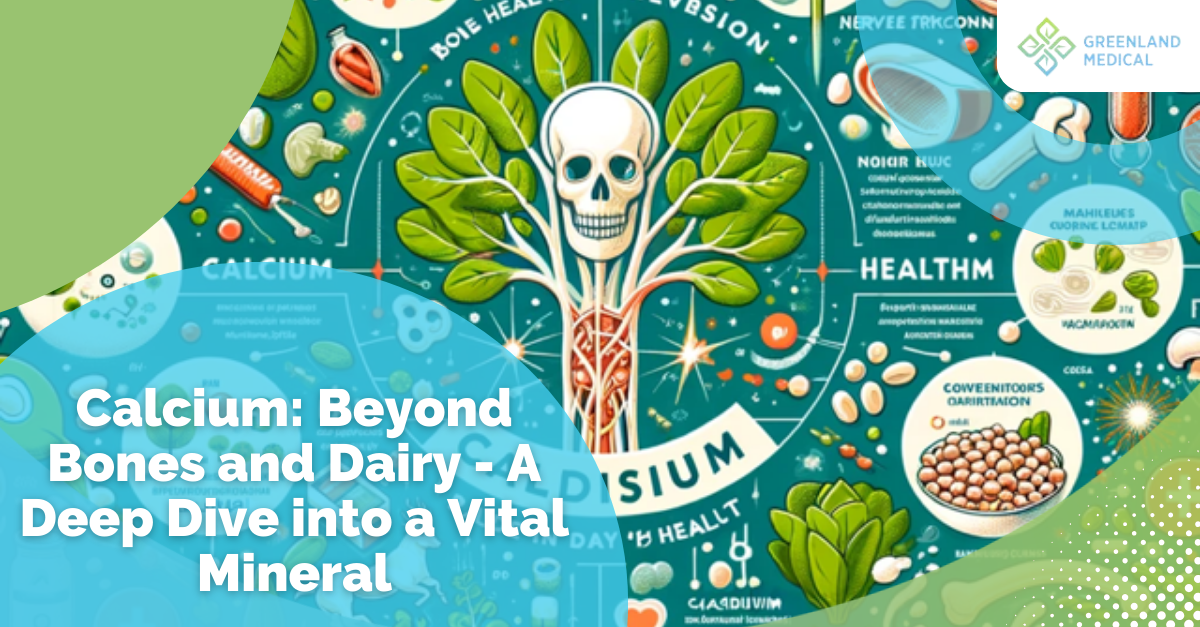
By Dr Andrew Greenland
•
14 Dec, 2023
For most people, calcium is widely known as the building block of strong bones and teeth. But its influence on health goes far beyond this well-known area. It is essential to comprehend the many roles that calcium plays in the body and dispel common misconceptions about the foods that contain it. This is especially true in a world where people are making more informed and varied dietary choices. The Diverse Functions of Calcium in Health One of the most important elements in our body, calcium coordinates several essential processes. It plays a crucial role in blood clotting, which is a necessary procedure for wound healing. Calcium serves as an essential messenger in the field of nerve transmission, enabling nerve cells to communicate with one another. Muscle contractions, especially the vital heartbeat, depend on this function. Furthermore, calcium is essential for several physiological activities, including hormone release, enzyme activity, and cellular signaling. Disproving the Dominance of Dairy Let's now tackle the big issue: the pervasive notion that dairy is the main, if not the only, dietary source of calcium. Despite its popularity, this idea ignores a wide range of calcium sources that aren't dairy products. What food do cows consume? Lawn. This straightforward query directs our attention to a wider range of calcium sources derived from plants. Leafy greens that are high in calcium include bok choy, collard greens, and kale. Legumes, such as beans and lentils, are high in protein and fiber in addition to providing calcium. Some notable sources are almonds, chia seeds, and fortified plant milks (almond, soy, and oat milk). For people who are lactose intolerant or follow a vegan diet, these options are very pertinent. The Debate Over Dairy and Bone Health According to a controversial idea in nutritional science, dairy products may, ironically, be responsible for the depletion of calcium in bones. The idea of acidic metabolic ash caused by dairy consumption is central to the debate. Theoretically, in order to neutralize this acidity, bones must lose calcium, which weakens the bones. Despite the growing popularity of this hypothesis, it is imperative to examine it with scientific rigor. The state of research is complicated, with different studies producing different conclusions. It emphasizes the value of eating a balanced diet and the possible consequences of consuming too much of any food group, including dairy. Including Calcium in a Balanced Diet Variety is essential for a well-rounded approach to calcium intake. Consuming a variety of dairy and plant-based foods helps provide a high-quality calcium intake, which is advantageous for bone health and other areas. It's critical to take into account elements that support the absorption and utilization of calcium, such as magnesium and vitamin D. Conclusion The benefits of calcium to our health go far beyond just strengthening our bones and teeth. It conducts many physiological symphonies silently. Getting our calcium from sources other than dairy not only fits in with different dietary preferences, but it also increases our nutrient intake overall. As we make our way through the plethora of nutritional options and knowledge, let's not forget how important and adaptable this important mineral is.

By Dr Andrew Greenland
•
14 Dec, 2023
The fluoridation of drinking water is a contentious issue that has long been at the center of public health issues. Opponents voice concerns about potential health hazards and ethical ramifications, while supporters highlight the benefits it has for dental health. In addition to focusing on fluoride, this topic raises a more general ethical question: should public water sources be tainted in order to avert widespread disease? To take an extreme example, the idea of putting drugs like statins in our water raises serious concerns about consent, autonomy, and public health. The Fluoridation Argument The 1940s saw the introduction of fluoridation of water, which is hailed as a success for public health. Regardless of age, socioeconomic status, or access to care, it is recognized for having greatly decreased dental caries, or tooth decay, in communities. Water fluoridation was recognized by the Centers for Disease Control and Prevention (CDC) as one of the ten greatest public health accomplishments of the 20th century, citing a significant decrease in dental decay. Fluoride immediately strengthens tooth enamel, increasing the teeth's resistance to acid produced by oral bacteria. The Reluctance to Fluoridate In contrast, other experts contend that systemic fluoridation may be a factor in health problems, citing research that connects high fluoride exposure to diseases including skeletal fluorosis and possibly even lower IQ in youngsters. Ethical considerations are also crucial: does the bulk prescription of a population without individual agreement violate people's right to privacy? The balance between the interests of the group and those of the individual is what drives the discussion. The Argument of Slippery Slope A more general, philosophical query that arises from the fluoridation controversy is: if fluoride is in our water supply, why is it not also the case for other preventive drugs? Let's imagine that statins are added to water in an attempt to prevent heart disease. Even if it is absurd, this idea emphasizes the value of agreement and the possibility of overreaching in public health regulations. When does the benefit of the community end and individual rights begin? A Critical Evaluation The benefits of fluoride in avoiding dental cavities are widely established; nonetheless, the arguments against fluoridating water bring up important ethical concerns in public health. A fundamental tenet of medical ethics, autonomy promotes informed consent and personal decision-making. Even in the best of cases, widespread prescribing may be considered a breach of this rule. Furthermore, as scientific knowledge advances, the effectiveness and safety of such procedures must be continuously evaluated. Conclusion The great fluoride debate is a stand-in for more significant discussions about public health, individuality, and the role of government in the medical field. It is not simply about tooth health. The slippery slope argument is a useful cautionary story in this situation, even though it occasionally contains logical fallacies. The methods we use to attain our aims of healthier society are just as crucial as the results. To ensure that our goal of community health does not come at the expense of individual autonomy, it is imperative that we maintain a balance between the benefits of public health and individual liberties.
Latest news

By Dr Andrew Greenland
•
04 Apr, 2024
Alzheimer’s disease, a formidable foe in the realm of cognitive disorders, remains a significant concern in our aging population. Central to this battle is understanding the genetic underpinnings of Alzheimer’s, notably the APOE4 gene. APOE4, a variant of the Apolipoprotein E gene, has been identified as a key genetic factor influencing the risk of developing Alzheimer’s disease. The APOE4 Gene: A Double-Edged Sword APOE4 is not just a marker for Alzheimer’s; it serves a broader role in lipid metabolism, impacting cardiovascular health. Individuals with the APOE4 variant may experience altered blood lipid profiles, potentially increasing their risk for cardiovascular diseases. This multifaceted impact underlines the gene’s significance in holistic health assessments. Empowerment Through Genetic Knowledge Understanding one’s APOE4 status transcends mere knowledge; it’s a strategic advantage in preemptive health management. Although genetics are a blueprint we inherit, they are not a fixed destiny. The burgeoning field of epigenetics teaches us that environmental factors and lifestyle choices can influence how genes are expressed. This principle is at the heart of the Bredesen protocol, which recognizes APOE4 status as a pivotal diagnostic marker. The Bredesen Protocol: Tailoring Treatment to Genetic Insights For practitioners and patients alike, knowing APOE4 status is empowering. It allows for specific adjustments to holistic treatment plans, ensuring patients thrive despite their genetic predispositions. The Bredesen protocol, an integrative approach to Alzheimer’s treatment, leverages this genetic insight to craft personalized strategies that address the multifactorial nature of the disease. Genetic Testing: A Proactive Approach to Alzheimer’s Prevention For those with a strong family history of Alzheimer’s, genetic testing, including APOE4 status, is a valuable tool in early prevention strategies. Understanding genetic risks enables individuals and healthcare providers to implement targeted interventions focused on lifestyle, nutrition, and other modifiable factors to optimize brain health and potentially delay or prevent the onset of Alzheimer’s. The Role of Qualified Practitioners in Genetic Navigation Navigating the complexities of genetic testing and interpretation requires expertise. Working with a qualified Bredesen practitioner can be invaluable. These practitioners are equipped to not only understand the nuances of genetic tests but also to empower patients with targeted strategies. They focus on optimizing brain health in the face of genetic risks, creating a proactive and personalized approach to Alzheimer’s prevention. Conclusion In the journey of health and wellness, knowledge indeed is power. Understanding one’s genetic makeup, particularly the APOE4 status, offers a unique advantage in preemptively managing health risks. It empowers individuals and healthcare professionals to make informed, targeted decisions, turning genetic insights into actionable strategies for thriving health.

By Dr Andrew Greenland
•
01 Apr, 2024
The Ayurvedic Jewel: A Journey through Time Ashwagandha, a name that resonates with a history as rich as its properties, is more than just an herb; it’s a testament to the ancient wisdom of Ayurveda. Originating from the sun-drenched plains of India and the Middle East, ashwagandha has been a cornerstone of traditional Ayurvedic medicine for over 3,000 years. Its botanical name, Withania somnifera, speaks of its essence – a blend of vitality and tranquility. Adaptogen: Nature’s Response to Stress One of the key highlights of ashwagandha is its role as an adaptogen. But what exactly does this mean? Adaptogens are a unique class of healing plants. They help restore balance and protect the body by enhancing its ability to cope with stress, fatigue, and anxiety. Think of them as a thermostat; when the thermostat senses that the room temperature is too high or too low, it brings it back to equilibrium. Similarly, adaptogens modulate our body’s stress response, maintaining an optimal balance. A Nervine Relaxant and Cortisol Modulator In today’s fast-paced world, where stress is often a constant companion, ashwagandha’s properties as a nervine relaxant are particularly valuable. It gently soothes the nervous system, acting as a balm to frayed nerves. This calming effect is partially attributed to its ability to regulate cortisol levels, the body’s stress hormone. By normalizing cortisol levels, ashwagandha helps reduce stress and enhance mood, offering a natural way to bring about relaxation and tranquility. Beyond Pharmaceuticals: The Gentle Power of Botanicals While modern pharmaceuticals have undeniably contributed to health and wellness, there’s a growing recognition of the benefits of botanicals like ashwagandha. These natural remedies offer a gentler, often safer alternative. Their multifaceted action, coupled with fewer side effects, makes them a preferable option for many seeking holistic wellbeing. Ashwagandha, with its myriad therapeutic actions, exemplifies the potential of botanicals in modern integrative healthcare. Embracing Nature’s Gift As we continue to explore the confluence of traditional wisdom and modern science, ashwagandha stands out as a beacon of hope and health. Its holistic approach to wellbeing – impacting physical, emotional, and mental health – aligns perfectly with the principles of Integrative Functional Medicine. Incorporating ashwagandha into daily life could be a step towards embracing a more balanced, health-focused lifestyle. However, it is important to remember that while botanicals offer immense benefits, they are part of a larger wellness tapestry that includes diet, exercise, and lifestyle.
Greenland Medical is the trading name of Greenland Medical Ltd, Registered in England (Company no. 12880034).
Registered Office address: 143 Station Road, Hampton, Middlesex, TW12 2AL

